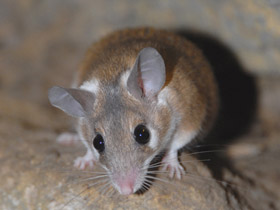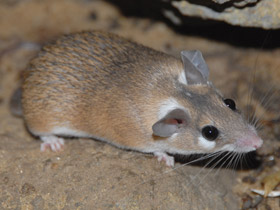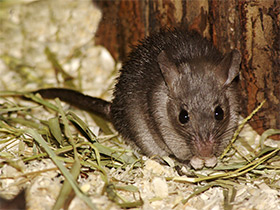The Cairo spiny mouse (Acomys cahirinus), Common spiny mouse, Egyptian spiny mouse, or Arabian spiny mouse
The Cairo spiny mouse (Acomys cahirinus), also known as the common spiny mouse, Egyptian spiny mouse, or Arabian spiny mouse, is a nocturnal species of rodent in the family Muridae. It is found in Africa north of the Sahara, where its natural habitats are rocky areas and hot deserts. It is omnivorous and feeds on seeds, desert plants, snails, and insects. It is a gregarious animal and lives in small family groups. It is the first and only known rodent species that exhibit spontaneous decidualization and menstruation.
Description and features
Acomys cahirinus is interesting because it grows needles on its back that look like hedgehog needles. When the animal is threatened, it tries to scare away its enemy by raising its needles to appear larger. These cute rodents inhabit rocky landscapes, barren deserts, savannahs and rocky placers. They are very mobile and active - they can run up to 15 kilometres per day. Acomys cahirinus live in small groups, led by alpha females. When a female gives birth to cubs, the other sexually mature females help her during labour and even feed the babies. Newborn Acomys cahirinus (there are from 2 to 5 of them) have open eyes and ears, developed thermoregulation, covered with fur with soft needles and almost immediately are able to move and feed on their own.
Status
The Cairo spiny mouse has a wide distribution and occupies diverse habitats. It is common and the population size large, so the IUCN, in its Red List of Threatened Species, lists it as being of "Least Concern".
Research interest
The spiny mouse is used for research in diabetes, development, regeneration, and menstruation.
The spiny mouse is also the first known rodent species to exhibit spontaneous decidualization and menstruation, potentially serving as a great candidate model to study menstrual related diseases. It exhibits a 9-day cycle, and is the first rodent found to have such a cycle. As of 2016, gene sequencing has been underway to investigate this, and other unique physiological traits displayed by this species.
The Asia Minor spiny mouse (Acomys cilicicus)
Cairo spiny mouse видео
The Asia Minor spiny mouse (Acomys cilicicus) is a species of rodent in the family Muridae. It is endemic to Turkey. Its range covers the eastern outskirts of the city of Silifke in Turkey. The mouse lives in colonies near human dwellings.
Appearance
Acomys cilicicus reaches a body length of 10-12 cm and weighs about 50 g. Like most needle mice, it is characterised by stiff spiny hairs, with inflexible upper tips (which look like hedgehog barbs). These mice are also characterised by large eyes and ears, and an almost bald tail, which is usually shorter than the body of the mouse, which is an essential feature of this species.
Habitat, rescue programme
Due to the fact that this species is threatened with extinction, a programme to save it is being implemented. At the same time, to avoid extinction, this species of mice is forbidden to be taken outside Turkey (unless authorised by the government), and only a few zoos in the world have representatives of this species (Prague and Helsinki zoos). It is noted that these mice reproduce in captivity and live for about 4 years. In addition, this species is cultivated as a pet - in England, Germany and Denmark.
Social behaviour, lifestyle and habits
Acomys cilicicus is nocturnal, but can be active during the morning and evening hours. This species is omnivorous and feeds on seeds, grasses and insects. Reproduction is continuous throughout the year, with a gestation period of 5-6 weeks. As a rule, 2-3 mice are born in the first litter of young animals, while adults have more numerous litters. Newborns of Acomys cilicicus are to a certain extent developed already at birth, as their eyes are usually open, their body is covered with wool and females completely wean them from suckling in a fortnight after birth. And after 2-3 months the young reach sexual maturity. The average life expectancy is 3-4 years.
Conservation status
Acomys cilicicus was previously listed as Critically Endangered, but is now considered Data Deficient because of taxonomic issues, as it may be the same species as the widespread and common northeast Cairo spiny mouse, Acomys cilicicus.













































